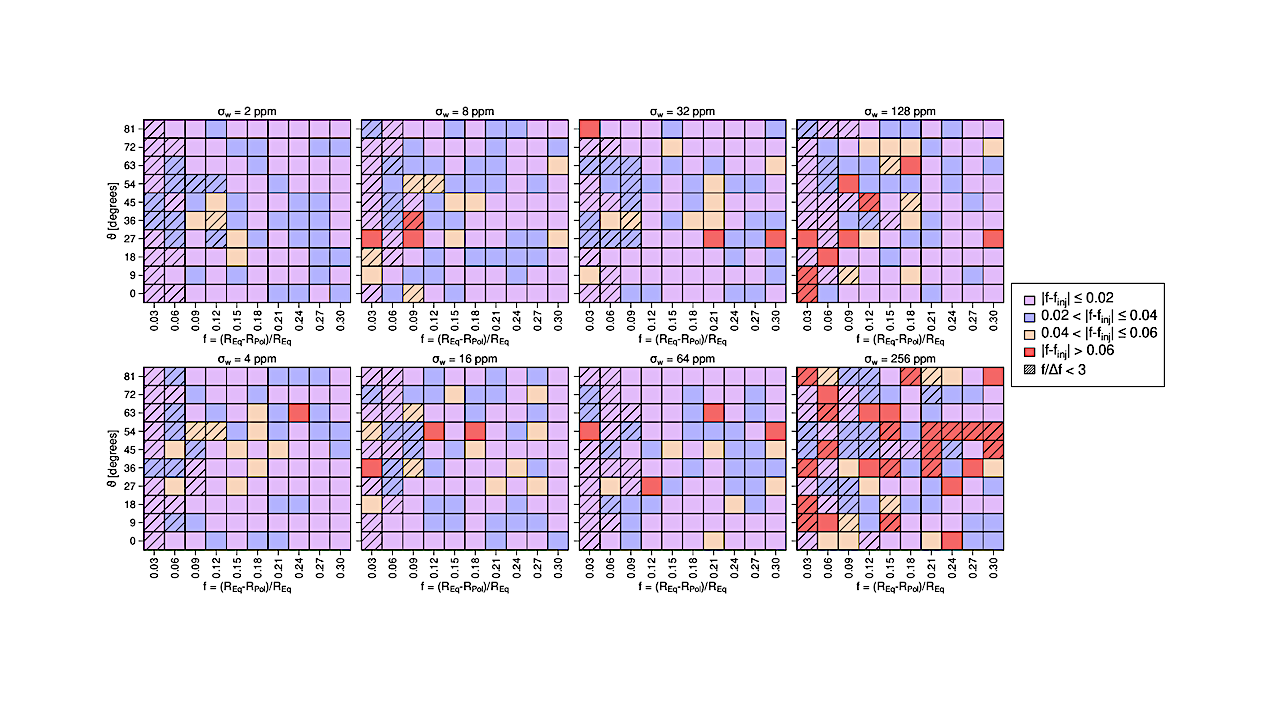Accuracy of the retrieved oblateness parameter in the light curve which included red noise, for all eight σw noise levels. Squares in the input f–ϑ grid are coloured based on the accuracy of the fitted f: purple if the retrieved parameter is within 0.02 of the injected value, blue if it is within 0.04, orange when it is within 0.06, and red otherwise. Shading is present when no significant detection of oblateness is made (i.e. when there is no 3σ detection of f). — astro-ph.EP
In the era of photometry with space-based telescopes, such as CHEOPS (CHaracterizing ExOPlanets Satellite), JWST (James Webb Space Telescope), PLATO (PLAnetary Transits and Oscillations of stars), and ARIEL (Atmospheric Remote-sensing Infrared Exoplanet Large-survey), the road has opened for detecting subtle distortions in exoplanet transit light curves — resulting from their non-spherical shape.
We investigate the prospects of retrieval of rotational flatness (oblateness) of exoplanets at various noise levels. We present a novel method for calculating the transit light curves based on the Gauss-Legendre quadrature. We compare it in the non-rotating limit to the available analytical models.
We conduct injection-and-retrieval tests to assess the precision and accuracy of the retrievable oblateness values. We find that the light curve calculation technique is about 25% faster than a well-known analytical counterpart, while still being precise enough.
We show that a 3σ oblateness detection is possible for a planet orbiting bright enough stars, by exploiting a precise estimate on the stellar density obtained e.g. from asteroseismology. We also show that for noise levels ≥256 ppm (expressed as point-to-point scatter with a 60~s exposure time) detection of planetary oblateness is not reliable.
Sz. Kálmán, Sz. Csizmadia, L. M. Bernabó, R. Szabó, Gy. M. Szabó
Comments: Provisionally accepted for publication in PASP on 18/07/2025. 23 pages, 17 figures
Subjects: Earth and Planetary Astrophysics (astro-ph.EP)
Cite as: arXiv:2507.15359 [astro-ph.EP] (or arXiv:2507.15359v1 [astro-ph.EP] for this version)
https://doi.org/10.48550/arXiv.2507.15359
Focus to learn more
Submission history
From: Szilárd Kálmán
[v1] Mon, 21 Jul 2025 08:10:49 UTC (2,197 KB)
https://arxiv.org/abs/2507.15359
Astrobiology, exoplanet,

